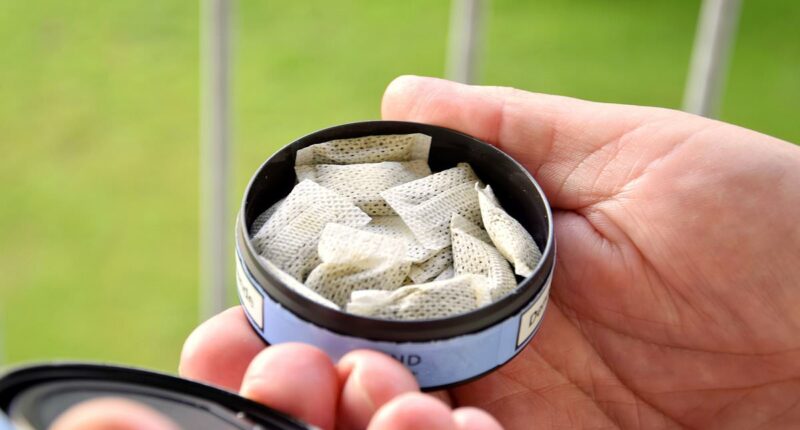Share this @internewscast.com
Poisonings linked to nicotine pouches have skyrocketed across the US, especially among young children, a new study has found.
Researchers in Ohio found a 763 percent spike in poisonings among children under six years old from 2020 to 2023.
The findings are particularly alarming given that the overall number of nicotine-related poisonings declined by 34 percent over the last eight years.
Out of more than 134,000 cases of pediatric nicotine poisoning, researchers found that children exposed to nicotine pouches were twice as likely to be hospitalized and 50 percent more likely to suffer serious medical outcomes, including seizures.
Nicotine pouches, small, typically white packets placed between the gum and upper lip, have gained popularity since they hit the US market in 2014.
Each pouch contains between two and 12 milligrams of nicotine, making them the second most popular nicotine product among young adults.
Just one to two milligrams of nicotine can poison a child, who is more at risk because of their small size, leading to sweating, pale skin and vomiting. In serious cases, it can cause tremors, seizures and even death.
Researchers noted that while many nicotine products have become less common in the home, nicotine pouches appear to be bucking the trend, with more cases involving children gaining access to them, often mistaking them for candy or chewing gum.

The above shows nicotine pouches, which have been linked to a spike in poisonings in the US (stock image)
Dr Hannah Hays, an emergency medicine physician who led the study, warned: ‘Nicotine pouches are a serious and growing toxic ingestion hazard among young children.
‘The rapid increase in the number and comparative severity of nicotine pouch ingestions is a reminder of the public health challenges of the changing nicotine product market.
‘This is why we need to continue ongoing surveillance and increase our efforts to prevent nicotine ingestions among young children.’
For the study, published in the journal Pediatrics, researchers extracted data on nicotine poisonings from the National Poison Data System, a data warehouse from America’s Poison Centers.
Scientists analyzed cases among children under six years old that occurred between 2010 and 2023, and that involved any one of five products: nicotine tablets, gums/lozenges, liquids, powder and pouches.
While nicotine pouches accounted for the fewest poisonings overall, just 1,800 cases, they were the only product to show a significant rise in poisonings in recent years, raising concern among researchers.
The data revealed that two-thirds of the children poisoned by nicotine pouches were under the age of two, and nearly all exposures occurred at home, suggesting increased availability and accessibility of these products in domestic settings.
The findings underscore the need for greater public awareness and preventive measures, as well as stricter packaging and storage requirements, to protect young children from accidental ingestion.

The above graph shows how the rate of poisonings linked to nicotine pouches (purple line) has surged in recent years compared to the others
Around 36 children experienced serious medical problems like seizures or breathing difficulties, but no deaths were reported.
Dr Natalie Rine, a toxicologist and director of the Central Ohio Poisoning Center, who was a co-author of the study, told CNN: ‘It’s a high-concentration nicotine product, and it tastes good.
‘There’s nothing telling the kid, “This is bad, you should spit it out”, and that’s where you get into trouble.’
Among cases where the source was known, e-liquids or e-cigarette fluids caused the most poisonings, with 33,000 cases. Tablets caused 23,000, powder 11,000, and gums or lozenges 8,000 cases.
They were followed by tablets, at 23,000 cases, powder at 11,000 cases and gums/lozenges at 8,000 cases.
Overall, 36 percent of ingestions had no effect, and 81.3 percent of cases did not require healthcare treatment.
Thirty-nine children suffered major effects, including seizures, and two died after consuming e-liquid.
Nicotine poisonings increased by 59 percent in the first five years of the study, then declined by 34 percent over the following eight years.

Researchers warn that as the pouches become more popular, they are more easily accessed by children at homes
There are no named cases of a baby being poisoned by a nicotine pouch.
Philip Morris International, which owns the nicotine pouch brand Zyn through its company Swedish Match, said in a statement that the number of poisonings from pouches remains low.
‘ZYN is the only nicotine pouch authorized by the FDA as appropriate to protect public health,’ a spokesman said, ‘In making that conclusion, the agency noted that ZYN’s packaging is designed to be child resistant’.
‘We welcome the chance to meet with these researchers and educate them on the robust actions Swedish Match takes to guard against underage use.’







